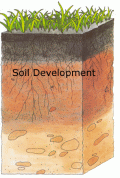NATURE OF SOIL
| HOME | LITTERATURE | CONTACT US |
| Structure or microstructure of soil |
| identification and classification of soil |
| Granulometric structure of soil |
| Phase relations and phisical state indexes of soil |
What is geomechanics? |
Geomechanics is technical discipline which applies rules of mechanics deformation body in civil engineering meaning.
|
| What is soil? |
Soil is natural mixture of mineral grains which can be separate on the way of mechanics. Frequently soil is uncemented gathering of granular material like are mineral and organic sources. Soil appears as product of many chemical, physical and mechanics processes of decomposed areas of rock (stone) parts which are exposed outside influences. Grains of soil appear in cyclic process of decomposed hard rocks (stones) because of temperature changes, Sun, water and chemical processes. Basicly, destructive processes which contains in creation of soil can be physical and chemicals.Physical processes- are participating in decomposing of fundamental stone (rock) to fragments, and little pieces of stones different dimensions. Frozen water in fissures causing a high level voltage and in that way the fragments become bigger so they are separated from the stone mass. Cyclic freezing and melting can cause demotion in the big depth. Also, the temperature differences causing changes of voltage and they can cause decomposing stone fragments. We must mention that physical processes which are participating in genesis of soil can be described by erosion of wind, water and glacier. Chemical processes causing a change type of mineral of fundamental stone because of water, special if there is some traces of acid, bases, and carbon dioxide. A huge number of minerals can be classify in four fundamental groups;
Soils as we find in nature, can be classified as a transport soils and residual soil .Transport soils are made up on one place, and later they are transported and deposit on another place. And residual soil is made up by staying on the place where the stone is crashed up. |




